
19 minute read
Project team members install a trash collection device, called a Litter Gitter, in a park located in Atlanta, Georgia
One of the results of decades of disinvestment in the neighborhoods of Atlanta’s Proctor Creek Watershed have been waterways disproportionately burdened by litter and trash pollution. In 2019, a community-driven litter and plastics reduction project kicked off as a partnership between Atlanta’s Parks and Recreation Department and Department of Watershed Management, the U.S. Environmental Protection Agency (EPA), the West Atlanta Watershed Alliance (WAWA), Groundwork Atlanta and Park Pride. Through their vision and with support from The CocaCola Company’s World Without Waste Campaign and NRPA, these neighborhoods have adopted innovative trash-catchment systems (trash traps) to help create cleaner and more vibrant waterways, parks and communities. Over the past year, the community has combined two trash trap technologies with green jobs training and litter education programs. The trash traps, installed within Atlanta’s parks, are improving water quality and stream habitat by removing the waste that heavily impacts these urban waterways.
Since trash traps sit within Atlanta’s parks, community members can easily see the systems, discuss the topic of waste in waterways and participate in educational outreach programs on the importance of litter reduction. The maintenance of these systems created local green jobs — employees gather data on the material collected and then properly recycle, reuse or dispose of these materials.
Advertisement
A History of Proctor Creek
Proctor Creek, a nine-mile tributary of the Chattahoochee River located on Atlanta’s west side, runs through residential, industrial, commercial and parklands. This waterway and its tributaries connect more than 35 Atlanta neighborhoods, many with local and national historical significance. It sits within a watershed encompassing approximately 16 square miles that is home to approximately 60,000 people.
Proctor Creek has been plagued by pollution, especially escaped trash and illegal dumping. When combined with a history of community neglect and increasingly flashy flow characteristics (the rapid increase in flow shortly after precipitation and equally rapid return to base conditions shortly after), the litter creates an unsafe environment for the surrounding neighborhoods. Nearby areas have experienced environmental and health issues from numerous brownfields (polluted land that was previously developed and is not currently in use) and potential Superfund sites (polluted locations requiring a long-term response to clean up hazardous material, as designated under the Comprehensive Environmental Response, Compensation
Many groups came together to make green innovative solutions a reality for Atlanta's Proctor Creek Watershed.
PHOTO COURTESY OF NRPA
WAWA and Workforce Development team members perform educational outreach by sorting trash and the Escaped Trash Assessment Protocol (ETAP).
and Liability Act of 1980), impaired water quality, pervasive flooding and combined sewer overflows.
Atlanta’s Westside neighborhoods, English Avenue, Vine City, Castleberry Hill, Ashview Heights and the Atlanta University Center — home to several historically Black colleges and universities — served as an incubator for African American leaders of the civil rights movement. These communities were home to some of Atlanta’s most notable citizens, including Dr. Martin Luther King Jr., Coretta Scott King, Maynard Jackson, Andrew Young and Julian Bond. While these communities are hubs of African American culture in Atlanta, they are also among the most impoverished in the city with about 67 percent living below the federal poverty level.
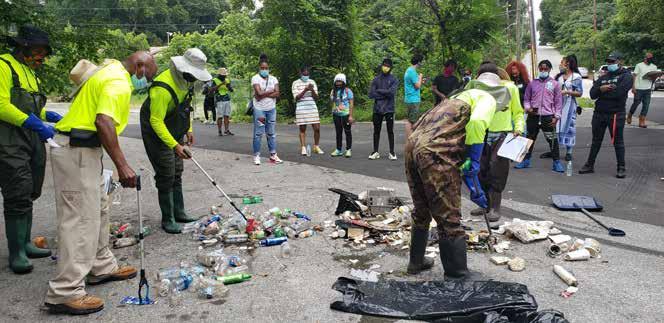
The Project and Technology
The trash catchment effort in Proctor Creek began with a study by Georgia Tech students. They analyzed the watershed to provide recommendations for the placement of the traps and assisted with design calculations to determine the hydrologic loading of the traps (volume of water capable for the traps to handle).
Using information from the Georgia Tech report, the project team decided to test two different trap technologies: • The Litter Gitter, produced by
Osprey Initiative — a smallstream litter collection device that uses floating booms to guide trash into a collection container. • The Bandalong Litter Trap, produced by Storm Water Systems
Inc. — a large, industrial-grade aluminum system that uses the water’s current to guide debris into a litter trap.
These passive systems are designed to capture floating debris without trapping wildlife. They have few to no moving parts, require minimal maintenance beyond emptying collected trash from the systems and allow stream currents to move trash into the collection receptacle. The locations and types of trash traps installed were selected to match the characteristics of the stream. The Bandalong’s heavy-duty construction and multiple anchoring points make it ideal for the strong, sudden flows that occur in Proctor Creek, while the flexibility and compact nature of the Litter Gitter make it suitable for the smaller tributaries.
Initially, five Litter Gitters were installed at three different park locations in the watershed. The Bandalong is located at the site of the future Proctor Creek Park; this waterway is the largest of all the locations, and requires a system, such as the Bandalong, to withstand its larger flows and larger debris.
The technology providers were able to offer expertise and assistance for this project that proved invaluable. When considering what technology to use, some vendors offer training while others can provide full service for rental and maintenance, which are important considerations for a successful project.
Throughout the past year, the sites and the technology were evaluated for their effectiveness. Smaller traps that don’t require multiple anchoring points are able to be moved easily. While this allows for nimbleness, they also are more susceptible to impacts from debris and storm surge. The Georgia Institute of Technology’s pre-project evaluation of the watershed and possible locations proved vital; however, having the ability to move traps based on efficiency helped to ensure a flexible program.
Gathering the Data
Data collected by analyzing the trash captured by the different technologies provides insight into the amount and types of trash found in the watershed and can help identify potential sources for this trash. For example, older trash can indicate a historic dumping site, while newer trash can point to the need for improving the number, location and emptying of receptacles. The methodology used to collect this information is called Escaped Trash Assessment Protocol (ETAP), which was created by the Trash Free Waters Program of the EPA (epa.gov/trash-free-waters). It is an easy way to collect reliable data on trash found in waterways and communities. The ETAP data shows the weight of materials collected, the waste type (paper, metal, glass, plastic, etc.) and categorical amounts (bottles, chip bags, cups, cans, etc.). Data collected reveals trends at each location and additional mitigation and outreach that should be employed. Projects should carefully consider the level of data needed and the ways this data might be used to help advance efforts in the local community.
The Atlanta sites have collectively removed a total of 454.22 pounds of recyclables and 1,040.52 pounds of trash from the watershed through the end of June 2020. The higher-capacity Bandalong, which is in a larger body of water fed by tributaries, accounts for more than half the material collected, even though it was installed in November 2019. The details from the ETAP process have helped the partners identify litter trends in specific parts of the watershed that are helping them form strategies for outreach to the community, as well as businesses to help prevent waste from entering Proctor Creek.
Workforce Development
Installing trash traps begs the question: Who will operate and maintain these devices? Groundwork Atlanta recognized this as an opportunity to increase green jobs and develop a workforce around the maintenance and operation of this technology in Atlanta. Through collaboration with Georgia Trade-Up, alongside the trash trap manufacturers, Groundwork Atlanta trained local crews on maintenance for each technology and methods to collect data utilizing ETAP. Currently, two teams each consisting of two to four local community members maintain both of the traps. Team members clean and collect materials from the traps on a regular maintenance schedule or after heavy rain.
By connecting Atlanta residents to employment created through this and other green infrastructure projects, benefits in local communities are multiplied. The value of investing in resources and people to help clean up the environment and maintain safer, healthier places to live, work and play cannot be understated.
Workforce Development team members clean and collect materials from the trash traps on a regular maintenance schedule or after heavy rain.
Education and Outreach
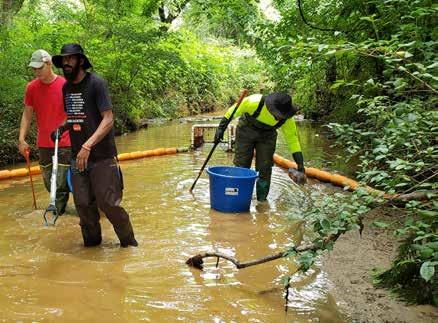
WAWA initially planned to educate Proctor Creek-area high school students on nonpoint-source pollution (pollutants accumulated in precipitation runoff that enters into waterways from land) its impact on waterways, as well as ways to use the ETAP process to understand the types of waste in local waterways. Their initial tours focused on working with the maintenance team to clean out the traps and the ETAP sorting activity, along with discussing watershed dynamics and nonpoint (stemming from many places) and point-source (stemming from a single place) pollution. But as COVID-19 started to impact communities in the early spring, in-person educational outreach had to be reconsidered. With WAWA’s extensive experience with engaging the local community, they pivoted and are creating an online portal with integrated educational videos, engagement and learning outcomes to educate local groups through a
virtual experience. This new platform will be able to virtually engage a broader audience while still allowing for the in-person educational experience when suitable.
Case Study for Others

The Proctor Creek project is helping the EPA and other cities and organizations learn how to incorporate trash trap technology and innovative workforces to address pollution in waterways.
“I believe that water issues are the largest and most immediate environmental and public health issues affecting the world right now,” says Andrew R. Wheeler, administrator of the EPA, in his 2019 remarks (tinyurl.com/y24jt864). Among those issues is litter in waterways; common trash from consumer goods is the major cause of pollution in our waterways and oceans. EPA is concerned about the effects of litter on the environment, wildlife and human health.
Partnerships are working to keep our public places and waterways clean from litter and create healthy ecosystems. Although it is a worldwide problem, solutions are being implemented within local urban communities, like Proctor Creek. “The Atlanta Department of Watershed Management is committed to improving the water quality in Proctor Creek and being a good steward of all our city’s 10 watersheds,” says interim Department of Watershed Commissioner Mikita K. Browning. “We look forward to working with and supporting our fellow community stakeholders and environmental partners through the Trash Trap initiative to help keep our local creeks and streams clear of trash and debris.”
Throughout the Proctor Creek project, other groups have reached out to discuss installing trash traps in their communities and to identify best practices and ways to replicate the program in other locations. It also contributed to the creation of The River Network’s newly released toolkit, Waste in Our Waters: A Community Toolkit for Aquatic Litter Removal (tinyurl.com/yybavyku). This toolkit has been released to help other organizations across the country explore the trash trap concept in their communities.
Several universities also have made a connection to discuss the impacts of the project and to use data collected to improve litter trap technology to spur future innovation in this area. New technology is continuing to surface in the trash trap arena and will only continue to expand the effectiveness of the technology to clean waterways.
Through the past year, plans have been made for how this project can continue impacting the watershed and what additional partners can help. Chattahoochee Riverkeeper (CRK), which was already working on a separate trash catchment program, will assist in stream litter collection efforts in Proctor Creek from a strategic environmental lens and help support the workforce development teams.
When undertaking a similar project, it is crucial to involve nonprofit, community, government and philanthropic partners to maximize the layered technological, environmental and socioeconomic impacts of these projects and retain a holistic vision for watershed restoration. With strong partnerships in place, this new innovative program will hopefully continue to benefit Atlanta and the Proctor Creek Watershed and serve as an example for other communities.
The Bandalong Litter Trap is a large, industrial-grade aluminum system that uses the water’s current to guide debris into a litter trap.
Special thanks to Glen Behrend (City of Atlanta, Department of Watershed Management); Cynthia Y. Edwards, PE (Region 4 Urban Waters, EPA); Carley Queen (Groundwork Atlanta); Darryl Haddock (West Atlanta Watershed Alliance); and Jordan Yu (Chattahoochee Riverkeeper) for the information they provided for this article.
Aaron Lee Wiener, PLA, is a Landscape Architect for City of Atlanta Department of Parks and Recreation, Office of Park Design (alwiener@atlantaga.gov). Michele White, CAE, IOM, is Conservation Program Manager at NRPA (mwhite@ nrpa.org).
OPERATIONS
The Benefit of Walking Tracks
By Cory Corullo
One way communities can support people who want to get and stay healthy is by providing opportunities for an active lifestyle. The best options are easy and accessible to all ages and abilities, since according to America Walks, “less than 50 percent of youth and 24 percent of adults get enough physical activity.” Walking is a great option that offers benefits for all ages, supporting both physical and mental health, without the need for any special skills or equipment.
To promote walking, communities can integrate walking tracks in schools and public recreation facilities. Even though no special equipment is needed, the type of track material does make a difference. The best choice considers the track’s overall functionality and durability along with the walker’s comfort and safety. Tracks can be constructed using a variety of materials, like asphalt or concrete, but synthetic track systems offer multiple advantages.
Engineered for the Optimal Health and Enjoyment of Users
Synthetic urethane and acrylic floor systems have become the most common type of track installed around the world and a standard for major athletic competitions. These are designed based on performance standards for different activities, taking into account factors like durability and shock absorption to help keep users healthy. Adequate shock absorption reduces stress on joints and lowers risk for short- and long-term injury.
Community walking tracks are a versatile amenity, fit for a range of activities for competitions, avid walkers and families. It’s easy to physically distance and still maintain relationships and healthy interactions for virtual runs and walks. Indoor tracks with temperaturecontrolled environments are especially popular for year-round physical activity. Indoors or outdoors, tracks help residents develop more regular walking routines, as well as offer alternative environments that are safe and away from traffic.
PHOTO COURTESY OF ACTION FLOOR SYSTEMS Synthetic tracks can help promote walking, an activity that provides mental and physical health benefits for people of all ages.
Durability and Ease of Maintenance for Inside or Outside Tracks
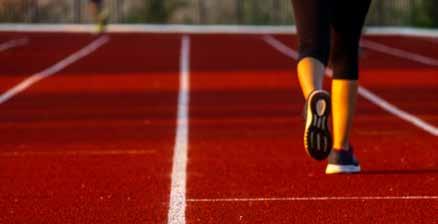
Since walking is an any-season sport, durability and ease of maintenance are critical to keeping tracks consistently accessible. Synthetic urethane and acrylic tracks are preferred for their durability, resistance to weathering and relatively low maintenance required to retain an even surface. They’re also spike resistant. In contrast, natural materials like concrete, asphalt or wood chips require constant upkeep to fill holes and level the surface, especially after inclement weather.
Synthetic urethane and acrylic track systems offer a seamless and non-porous surface that makes them easier to keep clean and sanitary. There are no grout and cracks where germs and harmful bacteria can saturate or hide. Plus, they resist odors and don’t absorb sweat. A variety of coatings are available for proactive resistance to fungus and bacterial growth.
Adding a walking track to your educational sports or community recreation area encourages an active wellness culture in your community and helps make it a better place to live for everyone. Work with an experienced athletic floor system contractor to review the specifics of your location and identify the best synthetic urethane and acrylic track system that’s enjoyable for all. Let’s get walking!
Cory Corullo is the Director of Synthetic Sales at Action Floor Systems, LLC (cory@actionfloors.com).
Making Public Restrooms Safe During COVID-19
By Kip Earlywine
Some people will experience fear or anxiety when using a public restroom in the coronavirus (COVID-19) era. During this time, we should strive to protect visitors the best we can. Here are some ways to keep your public restrooms safe during the COVID-19 pandemic:
Restrict Access to Some Fixtures to Create Separation Between Users
The Centers for Disease Control and Prevention (CDC) has broadly recommended people keeping a distance of six feet from all others at all times, when possible. Unfortunately, most restrooms were not designed with this kind of distancing in mind — sinks and urinals are generally about half that distance away from each other. By taping off or covering every other sink or urinal, it sends a very clear message for users to avoid them.
Make Your Hand Dryers Inoperative
It is believed that COVID-19 spreads primarily through tiny water droplets expelled through the breath of infected individuals. Hand driers produce high-speed turbulence that keeps these droplets suspended in the air indefinitely, making the air within the restroom unsafe. Disabling these devices and replacing them with a touchless paper towel dispenser are strongly recommended. Those paper towels also can be useful for visitors to use while touching the door handle when leaving the restroom.
Remove as Much Surface Contact as Possible
Replace existing fixtures with hands-free activators. This could include toilets, urinals, faucets, soap dispensers, paper towel dispensers and hand-sanitizing liquid dispensers. Typically, these are battery operated and some are relatively easy to install. If possible, keep the entry door open (or remove it completely). For outdoor restrooms, consider using a privacy screen in front of the entrance to maintain privacy with an open door.
Frequently Refill Soap and Hand-Sanitizer Dispensers
With people washing their hands at higher rates than before, there may be people going into your restroom just to wash their hands and nothing else! You can expect these supplies to need more frequent maintenance than in years past. This is one of the simpler, yet more critical, things you can do to make your restroom safer.
Maximize Ventilation
Introducing outside air into the restroom space through ventilation can remove airborne droplets quickly. This is the easiest and most effective way to reduce airborne transmission of pathogens. Therefore, make sure that you have open windows and vents in the restroom. If you have a bathroom fan, it should be set to run continuously.
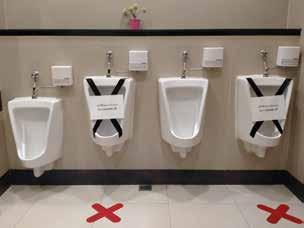
Restricting access from some fixtures within public restrooms can help keep patrons at a safe distance from each other during the COVID-19 pandemic.
Disinfect Fixture Handles and Buttons Frequently
Transmission of coronavirus may come from touching common surfaces that an infected person had previously touched. We recommend frequent disinfection of any permanent surface a visitor might touch with their hands, particularly the door handles on the stalls and entry door.
Easing the Public’s Concerns
It’s best to find ways to keep your visitors at safe distances while minimizing their need to touch things and maximizing the air flow and access to hand sanitation. If precautions are taken, users should feel reasonably safe using public restrooms.
Kip Earlywine is Blog Editor for Green Flush Restrooms (kip@greenflushrestrooms.com).
NRPA SOCIAL MEDIA
@NationalRecreationandParkAssociation @nrpa_news @nrpa National Recreation and Park Association
NRPA
CONNECT
nrpaconnect.org
nrpa.org/connect-app
Blog
nrpa.org/blog
parksandrecreation.org @parksrecmag openspaceradio.org
(or your favorite podcast app) @openspaceradio
Bright Ideas Shops, LLC. ..............................................54
DOGIPOT...........................................................................53
Ice-America........................................................................52 Landscape Structures Inc. ............................................... 3
Pilot Rock/RJ Thomas Mfg. Co. .................................. 11
Victor Stanley.....................................................................13
(ISSN 0031-2215) is published monthly by the National Recreation and Park Association, 22377 Belmont Ridge Rd., Ashburn, VA 20148, a service organization supported by membership dues and voluntary contributions. Copyright ©2020 by the National Recreation and Park Association. Reproduction in whole or in part without permission is prohibited. Opinions expressed in signed articles are those of the writers and not necessarily those of NRPA. Issued to members at the annual subscription price of $30, included in dues. Subscription: $46 a year in the U.S.; $56 elsewhere. Single copy price: $7. Library rate: $58 a year in the U.S.; $68 elsewhere. Periodical postage paid at Ashburn, Virginia, and at additional mailing offices. Editorial and advertising offices at 22377 Belmont Ridge Rd., Ashburn, VA 20148. 703.858.0784. Postmaster, send address changes to Parks & Recreation, 22377 Belmont Ridge Rd., Ashburn, VA 20148.
A Bike Park for Everyone
“If you build it, they will come” has been the mantra for the staff of the all new Crown Mountain Bike Park, centrally located between Aspen and Glenwood Springs, Colorado. The build of the bike park follows the construction of the Aspen Snowmass/Roaring Fork Valley International Mountain Biking Association (IMBA) Ride Center, which was awarded IMBA’s Gold designation for its world-class single-track mountain biking inside of a 50-mile radius, making the Aspen Snowmass/Roaring Fork Valley Ride Center one of seven locations in the world to receive this rating. In addition to the Gold-designated park in the Roaring Fork Valley of Colorado, there now lies a world-class biking training ground in the middle of the valley thanks to Crown Mountain Bike Park.
The new Crown Mountain Bike Park is anticipating 140,000 riders during 2021, and is planning to create a new bike school, as well as to form a local elite team of the valley’s best riders. Popularity of the park has exploded due to its progressive design, which includes features that focus on every stage of a rider’s development. The Crown Mountain Bike Park team has built a park that trains your kid for you. The park is a giant bike playground that has something for a two-year-old on a strider, a pro dropping in for a session and every rider in between. No matter people’s level of riding, they have something to ride here.
The variety at Crown Mountain Bike Park is second to none. The park includes a kids strider track, BMX race track, asphalt pump track, intro to mountain biking zone, five lines of progressive dirt jumps, mulch jumps, a green cross-country loop with features for beginners, a blue/black cross-country loop with features for intermediate to advanced riders, a wooden drop progression allowing riders to practice airborne drops, wooden wall rides, elevated wooden riding sections called “skinnies,” an expert back bowl with drops, jumps and wall rides, and a bike jump air bag.
Biking is not all that Crown Mountain Park has to offer. With your next visit to this gem, you will find 124 acres of open space that brings 67,000 visits by local athletes a year, and 120,000 annual dog visits and 400,000 total visits. Crown Mountain Bike Park is anticipating being open nine months of the year. The park is free to the public and open sunrise to sunset. The project to build the bike park was funded by Crown Mountain Park, sponsorships from companies and Great Outdoors Colorado, which awarded the park a $168,000 grant. The rest of the project was supported by in-kind donations from local companies. – Nate Grinzinger, Crown Mountain Park Bike Park Director
The new Crown Mountain Bike Park features a progressive design with features that focus on every stage of a rider’s development.
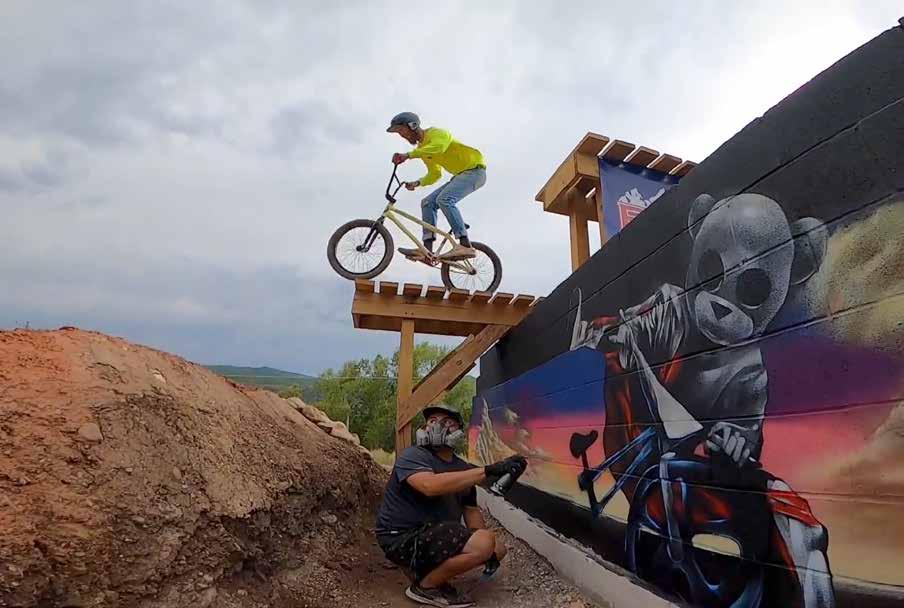
PARKS & RECREATION NOVEMBER 2020 ◆ P&R SYSTEM PLANNING IN A NEW ERA ◆ STRENGTHENING AGENCY-FOUNDATION RELATIONSHIPS ◆ CLEAN WATERWAY SOLUTIONS



